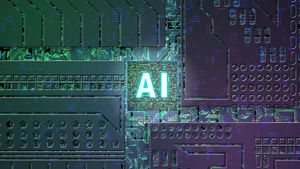
Since the first industrial revolution in the 18th century, technological innovation has driven human prosperity – though unequally. Nations with physical infrastructure, such as factories, steam engines, canals and railways surged ahead, while those without lagged.
Today, amid the Fourth Industrial Revolution—characterized by artificial intelligence and cloud computing — infrastructure is less of a barrier to growth. With broadband availability expanding even in least developed countries (LDCs), particularly in urban areas, the playing field between California and Cambodia is more level than ever.
AI, in particular, holds the potential to drive leaps in productivity and growth for developing nations, both through the adoption of innovations from developed countries and the creation of homegrown advancements.
However, while talent and connectivity may be increasingly widespread, capital remains concentrated. By 2050, LDCs are projected to account for nearly 34% of global population growth, yet they received less than 2% of global foreign direct investment flows in 2022.
But this statistic does not fully capture the impact of international companies employing millions in developing countries to write software, manage data and develop AI-driven solutions. Nor does it reflect the economic, healthcare, education, and financial inclusion benefits derived from adopting AI technologies from abroad.
AI as a catalyst for employment growth
One of AI’s most promising upsides for developing countries is its potential to create employment opportunities. Examples from Dolma Impact Fund’s portfolio illustrate how AI-driven businesses are not only increasing developing market employment but also equipping workers with essential technical and management skills:
- Fusemachines: A U.S.-based enterprise AI products and services company, Fusemachines employs a global workforce of over 500 AI engineers and experts, the majority of whom are based in developing countries such as Nepal, India and the Dominican Republic. To bridge skill gaps in emerging markets, the company offers a one-year AI fellowship program to train potential employees.
- Cloudfactory: A U.K.-based company, CloudFactory employs nearly 7,000 people in Kenya and Nepal. The company specializes in preparing high-quality, structured datasets that enhance AI model accuracy and performance, accelerating deployment. Its AI Data Platform ensures trustworthy model inference and scalability.
However, the rapid expansion of an AI-powered workforce in LDCs is not without ethical concerns. Some AI data-labeling companies have been accused of exploiting workers with low wages and poor working conditions.
Investigations have uncovered that these companies unintentionally hired underage workers, and exposed staff to harmful information, including violence and sexual materials raising mental health implications.
To address these risks, ethical AI standards, particularly those led by investors like those supported by the Investor Council on Responsible AI are crucial. These frameworks play a crucial role in ensuring fair wages, safe working conditions, and the ethical deployment of AI in developing countries, where local regulations may be inadequate. This fosters a more inclusive and sustainable AI ecosystem.
AI’s impact on global innovation and ethical challenges
One of the primary topics at the 2025 World Economic Forum was the growing role of AI in global industries. The event highlighted AI’s ability to spur innovation across manufacturing, health, finance and development, allowing LDCs to bypass conventional development hurdles.
However, to avoid bias and promote inclusivity, experts emphasized the significance of ethical AI standards. Another area of emphasis was sustainability, with discussions on AI contributing to environmental goals, rather than exacerbating inequalities.
The need for international cooperation and collaboration to create fair and enforceable AI policies – particularly in areas with weak frameworks – was also brought to light.
AI in health care: Will developing countries benefit?
Health care is one sector where AI’s impact is undeniable. AI is driving advances in personalized medicine, drug discovery and diagnostics in developed nations. History suggests that once advanced medical technologies are adopted across developed nations, their prices eventually decline, making them more affordable elsewhere.
The emergence of AI-powered portable ultrasound devices, which are far less expensive and simpler to use than conventional ultrasound equipment, is a striking example. These tools have made essential diagnostic services available in rural and underserved regions.
Where a shortage of medical specialists is a recurring problem, AI-driven health care solutions are bridging health care gaps:
- In Malawi, the Area 25 Health Centre in Lilongwe implemented AI-augmented fetal monitoring technology, resulting in an 82% reduction in intrapartum stillbirths and early neonatal deaths.
- In South Sudan, Médecins Sans Frontières is trialing an AI-based tool that identifies venomous snake species from photographs, enabling faster and more accurate treatment with the correct antivenom.
- Companies like ADA health and Zebra Medical Vision are advancing diagnostics in resource-constrained environments. Ada Health’s AI-powered chatbot enables patients to self-assess symptoms, reducing unnecessary hospital visits.
- Meanwhile, Zebra Medical Vision’s AI technology provides cost-effective screening for cardiovascular diseases and osteoporosis, for a fraction of the cost of traditional diagnostic tests. The integration of AI with local population DNA sequencing and gene editing technologies like CRISPR could make early disease detection and personalized treatments more effective.
These examples demonstrate how AI can enhance health care accessibility in developing countries, offering life-saving innovations in environments with limited medical resources. Despite these promising developments, many AI-driven health care innovations may remain out of reach unless investors and policymakers prioritize equitable access.
Sustainable financing models, regulatory frameworks, and global health partnerships will be essential in ensuring that AI’s healthcare benefits extend beyond wealthier nations. See my article on how emerging countries are embracing AI to enhance health care for more information and examples.
Job displacement, governance gaps and data exploitation
Despite its potential, AI poses serious risks in developing countries, especially in the areas of data exploitation, regulatory gaps and employment displacement. AI is automating tasks that millions of workers depend on, even as it creates new jobs.
According to a 2024 Goldman Sachs report, up to 300 million full-time jobs may be replaced by AI-driven automation. Automation is threatening to displace low-skilled jobs in industries like manufacturing, retail and customer service. The solution? Reskilling and retraining programs to transition workers into AI-driven roles.
Governance remains another major challenge. While the European Union has introduced the AI Act to enforce ethical safeguards, many developing nations remain unprepared to regulate AI effectively.
This regulatory gap creates vulnerabilities, particularly in areas like facial recognition technology, which has been shown to have greater error rates for people of color, leading to wrongful arrests and biased surveillance.
Between 2016 and 2018, facial recognition trials in London produced a 96% false positive rate, incorrectly flagging individuals as persons of interest. Real-world examples, such as the wrongful arrests of Robert Williams in Detroit (2020) and Nijeer Parks in New Jersey (2019), demonstrate the dangers of using biased AI without adequate supervision.
In addition to surveillance, AI-driven discrimination also impacts hiring, banking and financial services accessibility. While AI-driven identity verification systems used by banks disproportionately flag non-white users, limiting access to necessary services, some AI-powered hiring tools have been known to reject applicants with non-Western facial features.
These biases highlight the urgent need for stricter AI regulations especially in developing countries, ensuring that AI serves all communities rather than reinforcing existing inequalities.
Data colonialism: the new AI divide
Data colonialism, in which AI big tech takes vast quantities of data from developing countries without providing them tangible benefits in exchange, is another issue of concern. These countries run the risk of turning into “algorithm takers” rather than “algorithm makers” if AI companies keep developing models with data from LDCs without making investments in local AI ecosystems.
A case in point: In 2024, the Dutch Data Protection Authority fined Clearview AI $32 million for illegally collecting biometric data, illustrating the increasing scrutiny around unethical AI data practices.
The road ahead for AI in LDCs
AI is undeniably reshaping the global economy, and developing countries are at a critical crossroads. AI has the potential to revolutionize health care and other industries, generate jobs and promote long-term economic growth, if used responsibly.
In addition to outsourcing AI work for cost savings, more international companies and investors should consider direct investment in developing market innovators, helping these nations become active participants in the AI revolution and furthering the potential to reduce global inequalities.
But, in the absence of adequate regulation and investment, there is a risk of widening disparities, permitting data abuse and denying developing countries access to AI’s advantages. Finding a balance between innovation and social responsibility is a challenge for AI leaders, investors and regulators.
Whether AI serves as a vehicle for global advancement or merely reinforces existing divides will depend on inclusive AI regulations, ethical investment strategies and fair labor practices.






